THE AMERICAN MACCAR LORRY.
Page 7

Page 8

If you've noticed an error in this article please click here to report it so we can fix it.
Unit Construction of Engine and Gearbox. Trebly-jointed Propeller Shaft.
A recent addition to the already long range of American machines now available is named as above. Although this is on lines very similar to those of others we beve veeently described, and which must be becoming well known to our readers, it is nevertheless possible that a eliort description of this latest arrival may be interesting.
The engine is a four-cylinder monobloc, 105 mm, by 135 mm. bore and stroke, developing 35 ii.p. at 1200 r.p.m. Extemally the appearance is neat and clean. The valves are all placed on one side, the valve-gear is enclosed by quicklydetachable covers, and adjustable tappets are provided. Lubrication is forced, two plunger pumps being employed, which supply the oil to the main bearings and connecting rods. The system is a simple one, and should be fool-proof. The ignition is taken care of by Eisemann dual magneto. The control is by means of spark and throttle levers on the steering wheel, with the addition of an accelerator pedal. The carburetter is a Stromberg, and this is supplied with a supplementary contvol in the way of a Pierce governor, which can be arranged to come into operation at a predetermined engine speed. The engine itself is supper Led on an underframe. tnit eonstruction is adopted, the engineeclutch-casing, and gearbox forming one component ;
the clutch itself is of Raybestosfaced plates in contact with hardened steel discs. It is very sweet in operation, and can be slipped frequently without suffering any injury.
The gearbox gives three speeds forward and a reverse, and is operated on the selector principle. It is so arranged that short stubby shafts can he employed, and roller bearings are utilized througt out. The transmission from the box to the rear axle is by a propeller shaft having three universal joints. It is 'divided in the middle, and the front portion of this shaft is supported .by a roller bearing near the rear end. The universal joints are •of the block and trunnion type. They are entirely closed by steel oil-retaining covers. Provision is made
in the centre one, in which allowance is inade for telescopic movement, for packing the rear end of
joint, oint, so as to prevent the escape of grease.
The front axle is a drop forging of "I " section, and is fitted throughout with Timken bearings. The rear axle is also a product of the Timken factory ; it is of the fullfloating type with overtype worm and wheel, manufactured by David Brown and Sons, Ltd., Huddersfield. The castellated driving shafts are integral with the hub caps. It is, of course, fitted throughout with Timken roller bearings. The worm, wheel and differential gear can be easily and quickly dismantled without removing the rear axle.
The frame is a pressed steel one
stiffly braced ; no fewer than five cross members are included. Semielliptic springs are fitted both front and rearThey are•of good length and width, those at the back being no less than 4 ft. 8 ins, centre to centre. The spring eyes are bronze bushed, the shackle pins are hardened and ground, and fitted with large greasers.
The steering gear is of the worm and sector type. On the model illustrated this is shown on the near side. In future this is to be altered and the column placed on the offside of the lorry. • The changespeed and brake levers, also, in the illustration shown in the centre, are to be placed on the off side, as is more usual in this country. Powerful brakes are used, the hand brake being fitted with internal-expanding shoes, and the foot brake external-contracting. Both operate on drums bolted to the rear wheels. The same drum, by the way, serves for both brakes.
The fuel supply is from a petrol tank placed under the seat, the capacity of this being 15 gallons. Complete with three lamps, horn, jack, set of tools, toolbox and front mudguards, the chassis sells for £650.
During the course of a short run, "round the houses," so to speak, on a lorry loaded with about 2 tons, we were able to note that the steering was very free, the changespeed gear simple in operation, and also that the engine pulled remarkably well. The carburetter is evidently a very efficient one, and rapid acceleration is possible without choking. The chassis is worthy of a place.




















